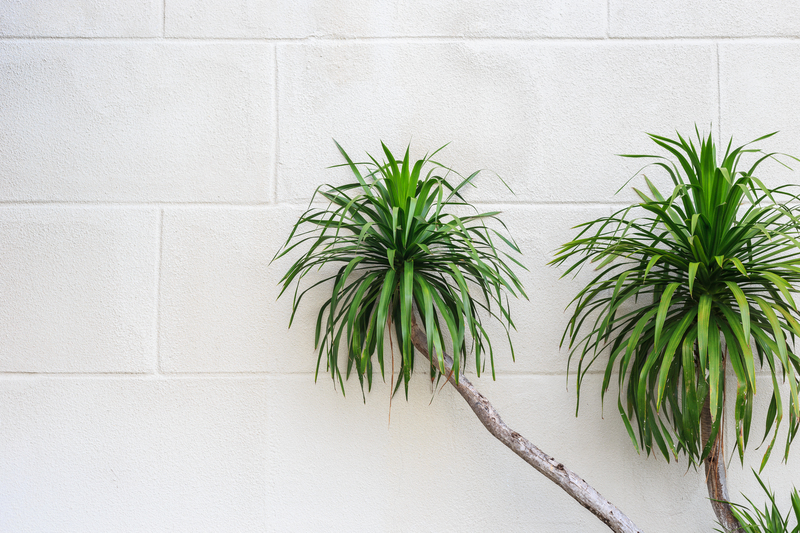Transform Your Space with Vertical Gardening
Posted on 25/06/2025
Transform Your Space with Vertical Gardening: A Complete Guide
Are you searching for innovative ways to refresh your home, apartment, or outdoor area? Vertical gardening offers the perfect solution to maximize your greenery without sacrificing floor space. Whether you're a city dweller with limited access to a backyard, a homeowner eager to add visual interest to your walls, or a gardening enthusiast looking for a new creative outlet, vertical gardens can transform any space into a lush, vibrant haven.

What is Vertical Gardening?
Vertical gardening is the practice of growing plants upwards on structures such as walls, trellises, towers, or even stacked containers. Unlike traditional gardens that spread across the ground, vertical gardens make use of vertical surfaces to display an array of plants, flowers, herbs, or even vegetables. This ingenious method creates living art, providing all the benefits of greenery while saving precious space.
The Rise of Vertical Gardens in Urban Living
As urban areas grow and living spaces shrink, the popularity of vertical plant walls and living walls has skyrocketed. Not only do they beautify otherwise blank walls or fences, but they also help purify the air, reduce noise pollution, and improve mental well-being -- all within a compact footprint.
Key Benefits of Vertical Gardening
Why should you consider transforming your space with a vertical garden? Here's how vertical gardens can offer extraordinary advantages:
- Space Efficiency: Utilize unused walls, fences, or balconies for your gardening endeavors. Vertical gardening is ideal for apartments, small patios, or offices with little to no ground space.
- Enhanced Aesthetic Appeal: Vertical gardens act as living artwork. They are visually striking and can even become a focal point indoors or outdoors.
- Air Quality Improvement: Many vertical plant systems help filter indoor air, removing toxins and providing cleaner, fresher oxygen.
- Noise Reduction: Lush green walls absorb and block noise, creating a quieter and more serene environment.
- Insulation: Living walls can help regulate temperature and reduce energy costs by cooling your home in summer and insulating it in winter.
- Productivity and Well-Being: Studies show proximity to greenery reduces stress, sharpens focus, and enhances overall health.
- Biodiversity Support: Provide habitats for pollinators, such as bees and butterflies, especially in urban areas.
Popular Vertical Gardening Ideas
Not sure where to start? Check out these creative ways to bring the vertical gardening trend into your living or working space:
- Wall-mounted Planters: Attach individual pots or planters to walls in various patterns to create eye-catching displays.
- Pocket Plant Walls: Use fabric or felt pockets designed for planting, perfect for herbs, flowers, and succulents.
- Repurposed Pallets: An upcycled wooden pallet makes a rustic and affordable vertical garden frame for flowers and small edibles.
- Trellis and Climbers: Grow vining plants such as tomatoes, peas, or flowering vines on a sturdy trellis.
- Hanging Baskets: Suspend baskets with cascading plants at different heights for a multi-layered garden.
- Tower Planters: Make or buy a vertical stack of pots to grow lettuce, strawberries, or herbs, especially perfect for patios and balconies.
- DIY Gutter Gardens: Mount old gutters on a frame or wall and fill them with herbs or leafy greens.
How to Set Up Your Vertical Garden
Step 1: Choose the Right Location
Evaluate the area where you want to install your vertical garden. Key considerations include:
- Sunlight: Assess whether you have full sun, partial shade, or mostly shade. Match your plant selections accordingly.
- Accessibility: Ensure you can easily access all parts of the garden for watering, pruning, and harvesting.
- Weight Support: Check that the wall or support structure can handle the combined weight of plants, soil, and containers.
Step 2: Select a Vertical Structure
You can either purchase a ready-made living wall system, build your own DIY structure, or get creative with recycled materials. Consider the following:
- Material: Metal, wood, plastic, or fabric.
- Size: Adapt the dimensions according to your available space.
- Integration: Should the garden be freestanding, wall-mounted, or hanging?
Step 3: Choose the Best Plants for Vertical Gardening
Not every plant is well-suited for vertical growth. Focus on varieties with shallow roots, compact growth habits, or vining natures.
- Herbs: Basil, mint, parsley, oregano, thyme, and chives
- Leafy Greens: Lettuce, spinach, kale, arugula, Swiss chard
- Flowers: Pansies, petunias, nasturtiums, impatiens, begonias
- Succulents: Sedum, echeveria, crassula, hylotelephium
- Climbing Vegetables: Tomatoes, beans, peas, cucumbers, strawberries
Step 4: Prepare Soil and Watering Systems
Good soil is the foundation of a healthy vertical garden. Use lightweight, well-draining potting mix, and consider adding slow-release fertilizer for nutrient support. Depending on the size, you might want a drip irrigation system or self-watering planters to keep maintenance simple.
Step 5: Plant and Arrange
Begin by arranging your plants thoughtfully. Place cascading varieties at the top for trailing beauty, mid-sized plants in the middle, and compact or shade-tolerant species lower down. Adjust as necessary for aesthetics and plant health.
Step 6: Maintain Your Vertical Garden
Regular vertical garden care involves:
- Checking soil moisture and watering as needed
- Feeding with fertilizer every few weeks
- Trimming dead or overgrown foliage
- Monitoring for pests and diseases
- Rotating annual plants to keep your vertical garden looking fresh
Design Inspiration: Vertical Gardening for Every Space
Indoor Vertical Gardening
- Living art walls with tropical or air-purifying plants deliver fresh style and breathable air to living rooms, bedrooms, or entryways.
- Kitchen herb gardens provide fresh flavors within arm's reach and encourage healthy, home-cooked meals.
- Bathroom plant walls featuring ferns or moisture-loving species create spa-like retreats with improved humidity control.
Outdoor Vertical Gardening
- Privacy screens and fences covered in vines offer natural barriers and increased seclusion.
- Patio and balcony displays can transform even the smallest concrete slab into a garden escape.
- Garage or shed wall gardens add unexpected charm and curb appeal to ordinary structures.
Top Plant Choices for Vertical Gardens
Explore these tried-and-tested options for successful vertical gardening:
- Pothos and philodendron: Tough, trailing houseplants ideal for low-light indoor gardens.
- Succulents: Low-maintenance and drought-tolerant, perfect for neglected spaces.
- Strawberries: Naturally suited to stacked planters or hanging gutters.
- Ferns and mosses: Best for shady, humid environments or bathroom plant walls.
- Orchids: Dramatic blooms that thrive in vertical slotted displays indoors or in warm climates.
- Edible greens: Lettuces, arugula, and baby kale give quick harvests in vertical planters.
- Flowering annuals: Impatiens, petunias, nasturtiums, and pansies add brilliant splashes of color.
Solving Common Vertical Gardening Challenges
How do I water my vertical garden?
Regular, even watering is crucial. Use a drip irrigation system or self-watering containers for larger walls. For smaller setups, water carefully from the top, ensuring excess moisture doesn't pool or run off too quickly.
What about plant nutrition?
Because vertical gardens have limited soil, nutrients can be depleted faster than in-ground beds. Use slow-release fertilizers or supplement with liquid plant food every two to three weeks.
How do I prevent pests and diseases?
Keep an eye out for signs of pests or mildew--proper air circulation and prompt removal of affected plants will help keep your living wall healthy. Stick with pest-resistant species for less maintenance.
Vertical Gardening: Eco-Friendly and Sustainable
Transforming your space with vertical gardening goes beyond aesthetics and function--it's also an eco-friendly lifestyle choice. Green walls can:
- Recycle greywater: Many systems are designed to reuse water efficiently.
- Improve microclimates: Living walls help stabilize temperature and humidity, reducing reliance on heating and cooling.
- Encourage native plants: You can support local ecosystems and pollinators by growing native species vertically.
- Reduce urban heat: Vertical greenery helps combat the "heat island" effect in cities.
Frequently Asked Questions About Vertical Gardening
- Can I build a vertical garden on any wall? Most sturdy walls and fences can support small to medium-sized vertical gardens, though check weight limits for internal or drywall surfaces.
- Is vertical gardening expensive? Start small with upcycled materials for an affordable garden, or invest in pre-made living wall kits for convenience.
- What is the easiest plant to grow vertically? Herbs and succulents are among the easiest and most forgiving choices for beginners.
- How much time does maintenance take? Simple vertical gardens may take as little as 10-15 minutes a week after initial setup, while larger systems may require more care and occasional replanting.

Get Started: Tips to Transform Your Space with Vertical Gardening
- Start Small: Try a single wall planter or hanging basket, then scale up as you gain confidence.
- Mix Plants: Combine flowers, edibles, and foliage for visual and practical rewards.
- Choose the Right Location: Place your vertical garden where it receives the right amount of sunlight and is protected from harsh winds or intense heat.
- Make Use of Recycled Materials: Old shoe organizers, gutters, and pallets make budget-friendly DIY options.
- Keep Learning: Join online forums, follow vertical gardening blogs, or visit local botanic gardens for inspiration.
Conclusion: Elevate Your Home with Vertical Gardening
Vertical gardening is more than a trend -- it's a transformative way to enliven your walls, improve your well-being, and celebrate nature, regardless of square footage. With the right set-up and plant choices, you can enjoy year-round color, fragrance, fresh produce, and a sense of serenity right at home.
Ready to embark on your own vertical garden journey? All it takes is imagination, preparation, and a passion for green living to truly transform your space with vertical gardening.
Take the next step and create your very own vertical oasis today!



